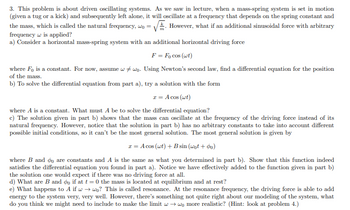Question

Transcribed Image Text:3. This problem is about driven oscillating systems. As we saw in lecture, when a mass-spring system is set in motion
(given a tug or a kick) and subsequently left alone, it will oscillate at a frequency that depends on the spring constant and
the mass, which is called the natural frequency, wo = However, what if an additional sinusoidal force with arbitrary
TTL
frequency w is applied?
a) Consider a horizontal mass-spring system with an additional horizontal driving force
F = Focos (wt)
where Fo is a constant. For now, assume wwo. Using Newton's second law, find a differential equation for the position
of the mass.
b) To solve the differential equation from part a), try a solution with the form
x = A cos (wt)
where A is a constant. What must A be to solve the differential equation?
c) The solution given in part b) shows that the mass can oscillate at the frequency of the driving force instead of its
natural frequency. However, notice that the solution in part b) has no arbitrary constants to take into account different
possible initial conditions, so it can't be the most general solution. The most general solution is given by
x = Acos (wt) + B sin (wot +90)
where B and do are constants and A is the same as what you determined in part b). Show that this function indeed
satisfies the differential equation you found in part a). Notice we have effectively added to the function given in part b)
the solution one would expect if there was no driving force at all.
d) What are B and do if at t=0 the mass is located at equilibrium and at rest?
e) What happens to A if w→wo? This is called resonance. At the resonance frequency, the driving force is able to add
energy to the system very, very well. However, there's something not quite right about our modeling of the system, what
do you think we might need to include to make the limit w→wo more realistic? (Hint: look at problem 4.)
Expert Solution
This question has been solved!
Explore an expertly crafted, step-by-step solution for a thorough understanding of key concepts.
This is a popular solution
Trending nowThis is a popular solution!
Step by stepSolved in 6 steps with 6 images

Knowledge Booster
Similar questions
- 1. A)Write down the second law as Hooke’s Law, and derive the solution for a frictionless mass-spring system. B) A 2.00-kg mass is observed to oscillate at 1.50 complete cycles/sec. What is the spring constant? C) How can you use a ball on a string to measure g?arrow_forwardA 500g block connected to a spring which the force constant is 5 N/m is free to oscillate on a frictionless, horizontal surface. The block is displaced 6cm from equilibrium and released from rest. Calculate the following: a.Period ofthe motion in seconds b.Maximum speed in m/s. c.Maximum acceleration in m/s2 d.Express the position, velocity, and acceleration as functions of time.arrow_forward1. Consider two systems experiencing simple harmonic motion: a mass-spring system and a pendulum. Which of these systems would experience a change in frequency if the mass in the system were changed? O The pendulum Both Neither The mass-spring system 2. A pendulum is hung from the ceiling of an elevator. When the elevator accelerates upwards, the period T of the pendulum is ✓the period when at rest. 3. A 2.70kg mass is hung from the ceiling by a string of length 1.60m and mass 0.00300kg. The string is plucked and a transverse wave travels through it. What is the speed of the transverse wave? m Sarrow_forward